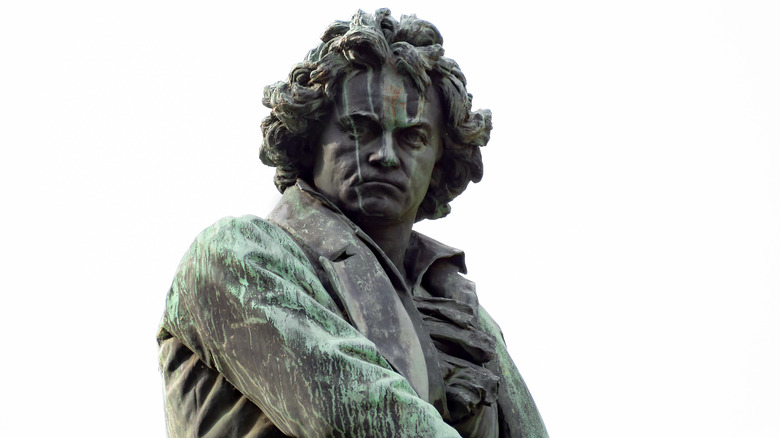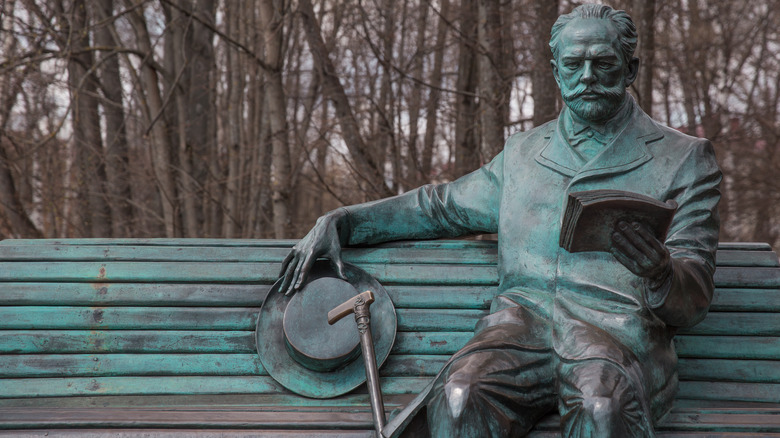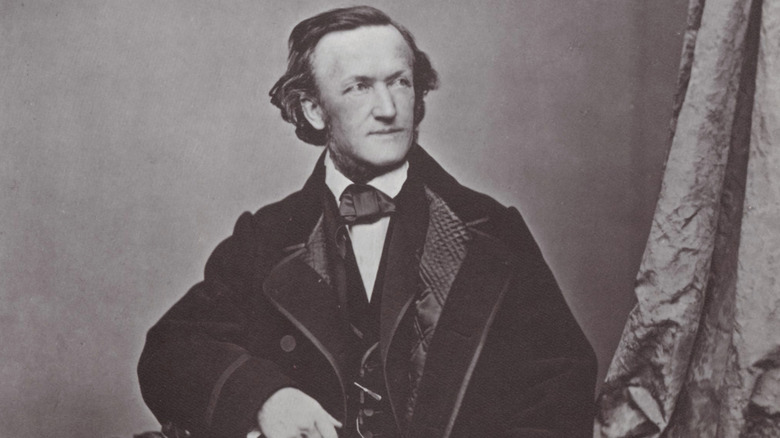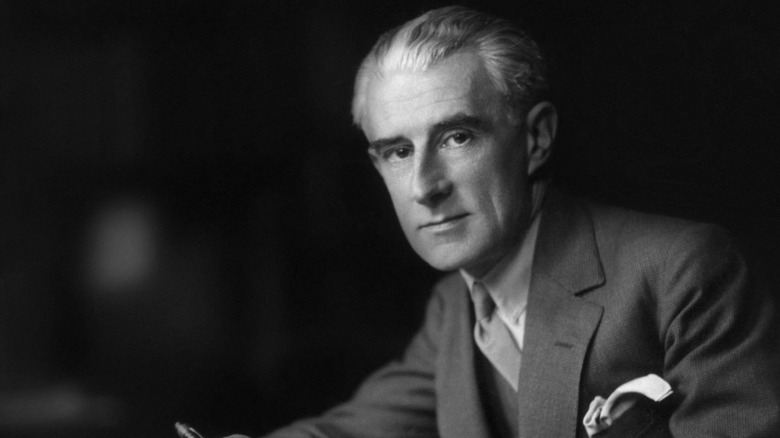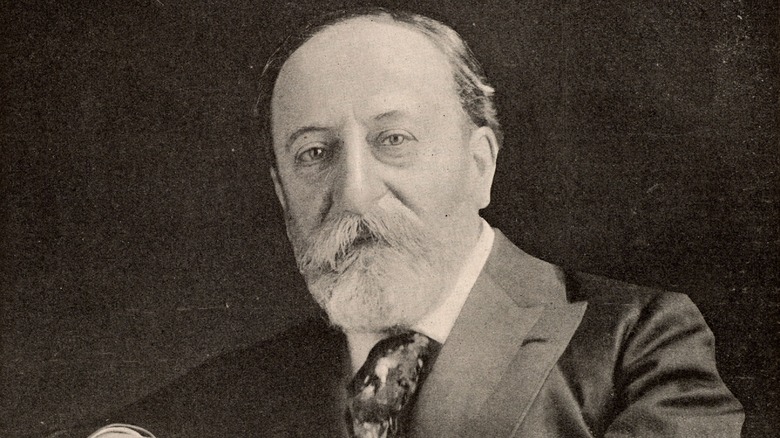Five Classical Musicians Who Hated Their Own Work
We know the story by now, right? A musician releases a song, the song gets popular, but the musician actually hates it. Maybe the musician resents how folks only remember the one song. Maybe to the musician, the song represents an immature, earlier era of music that's been left behind. Maybe the musician just got sick and tired of pretending to be enthusiastic about a 30-year-old track that audience members still go wild for but which they've come to loathe like a nagging illness. Nirvana, Led Zeppelin, Metallica, The Who, Queen, Radiohead, R.E.M., Madonna, Lady Gaga, Katy Perry, Frank Sinatra, Elton John: That's just a tiny, tiny sample of musicians who despise a song of theirs for some reason or another (per Loudwire, Insider, and Mama Mia).
So, should it come as any surprise that self-song-hating musicians have existed as long as there's been a public to consume their work? "Uninspired," "repugnant," having "little artistic merit," "really awful" — these are but a few insults that pre-modern musicians hurled at their own works, as The Guardian explains. Finnish composer Jean Sibelius burned not only his eighth symphony but a bunch of his other works, per Interlude; his wife says it "brought him great peace." The 17th-century Italian composer Arcangelo Corelli went many, many steps further and wanted to burn everything he ever wrote because he felt it wasn't perfect, per Classic FM. In the end, plenty of classical musicians hated their own work, and they were very vocal about their hatred.
Beethoven despised Septet, Op. 20
Everything you've ever heard about Ludwig van Beethoven being a grouchy contrarian and hot-headed perfectionist is completely true. The National News describes the 18th- and 19th-century German composer as the world's "first indie artist" and the "original tortured artist." Beethoven wasn't satisfied unless he outdid what he'd done before, and at every turn tried to do something different. He was also adamantly convinced of his own unparalleled talent, at one point saying to a critic, "What I s*** is better than anything you have ever thought," per The New Yorker. It should come as no surprise, then, that nobody was more critical of Beethoven's work than Beethoven himself. And as a 2007 study in the journal Psychology of Music says, Beethoven was a surprisingly accurate self-critic.
So we are we to make of a piece that Beethoven despised — "Septet, Op." — but fellow musicians were over the moon about, as The Guardian describes? It's true that the 1799 piece doesn't sound at all like the ultra-heavy, mournful work that many associate with Beethoven. It's exuberant, spritely, and downright whimsical. As a full list of Beethoven's music on the Petrucci Music Library shows, it's one of Beethoven's early-ish career works, written when he was in his late 20s. And so, Beethoven hated it not because it was poorly written, but because it was his overly-happy pop hit that didn't characterize him to the public in the way he preferred.
Tchaikovsky hated the 1812 Overture
Much has been written about Pyotr Tchaikovsky, Russia's first prominent international composer. The California Symphony describes him as "sensitive," "tormented," and "prone to immense angst, self-doubt, and bouts of depression." Born to a working-class family in the tiny town of Votkinsk in 1840, Tchaikovsky grew up fascinated with music and idolized musicians like Mozart, as Russia Beyond says. He grew to fame and acclaim in high circles but never owned a house. He married but was gay. And when he decided he'd had enough constant traveling, he settled in St. Petersburg and then died of cholera. Between it all, he feuded with composers like Brahms — whom he called "a conceited mediocrity" and "a giftless bastard" (per the Imaginative Conservatory) — and remained highly self-critical.
One of Tchaikovsky's most famous works — like his ballets "Swan Lake" and "The Nutcracker" — is the "1812 Overture." And if you think you haven't heard this work, trust us, you've heard it. It's an odd piece, to be sure — meandering, full of spliced-together motifs, and employing actual cannons at the end. And of course, Tchaikovsky loathed it. As Classic FM quotes, he called it "very loud and noisy and completely without artistic merit, obviously written without warmth or love." The work was commissioned as a Russian nationalist propaganda piece commemorating the Battle of Borodino in 1812 and was meant to inspire the love of country. Maybe that's why Tchaikovsky couldn't get behind it.
Wagner loathed Riezni
Before we say anything else about 19th-century German composter Richard Wagner, yes: He was an anti-Semitic scumbag and role model for Adolf Hitler, as Deutsche Welle discusses. Wagner's 1850 writing, "Judaism in Music," expresses his distaste for Jewish people because he believes they have no original art of their own, only art borrowed from other cultures throughout history. And while it would be lovely to separate Wagner from his work — folks like legendary Jewish composer and conductor Leonard Bernstein have done so, per The Local — it's all but impossible for even the most diehard Wagnerian to ignore Wagner's biases, politics, and nationalistic grandiosity.
All this is to say: Not only did Wagner dislike one of his early operas, "Rienzi," the work has fallen out of general favor in part because it employs anti-Semitic stereotypes and was a favorite of — you guessed it — Hitler, per The Detroit Jewish News. Wagner himself, as Australian Broadcasting Corporation recounts, called the work "repugnant" because he considered it too conventional. And yet, The Guardian describes the piece as moving and powerful, which only complicates sentiments towards Wagner and his work. At minimum, "Rienzi" could be called "conventionally Wagnerian" because it stays firmly in Wagner's tried-and-true wheelhouse: Nordic myth, just like his most famous works "Der Ring des Nibelungen" and "Die Walküre." "Rienzi" is big, brassy, and six hours long in its original form.
Ravel dismissed Bolero
And so we come to a 20th-century French composer with a decidedly gentle, flowing, anti-Wagnerian (anti-bombast, really) take on music: Maurice Ravel. Listening to Ravel is like listening to a painter: impressions pop and splash, sentiments unfurl and expand, and the music draws the listener into the quiet spaces between notes. As Totally History says, Ravel's father, Joseph, was an engineer and inventor. His mother was Basque-Spanish and a music lover. These two intellectual and cultural influences fused in Ravel, who from an early age loved music and studied composition. He performed his first recital at age 14.
With this information alone, it's possible to glean why Ravel didn't like one of his most famous pieces, 1928's "Boléro." It contains some of Ravel's trademark attention to compositional detail, but is highly repetitive and dispenses with much of the nuanced texture of his other works. It's 15 minutes long, has an incessant and unchanging marching beat, and repeats the same two musical phrases over and over. As Wisconsin Public Radio says, Ravel wrote it because another musician had already written an adaptation that he wanted to write. Critics razzed "Boléro," but the public loved it, as Classic FM states. Interlude states that Ravel called the piece "orchestration without music" and was baffled by why the public loved it. Ultimately, "Boléro" is a perfect example of listeners liking a simple, obvious composition rather than a musician's favored, more complex work.
Saint-Saëns hid The Carnival of the Animals
We round out this very non-exhaustive list with another 20th-century French composer, Camille Saint-Saëns. As AllMusic says, Saint-Saëns was a child musical prodigy and polymath who excelled in languages, math, astronomy, and more. He took a diverse approach to composition, writing not only chamber and full orchestral pieces, but songs — just that, songs — and small side pieces like accompaniments to plays, as the Petrucci Music Library shows. Like other composers, though, he preferred to be known for more serious, weighty pieces, as Interlude explains. And yet, his digressive way of working graced us with his most lighthearted, completely unplanned, and most famous work: "The Carnival of the Animals."
"The Carnival of the Animals" is a disarmingly sweet and charming, 14-part piece where each short part represents a different animal: turtle, elephant, donkey, etc. The kangaroo part sounds like a curious kangaroo hopping around; the swan part sounds like a gorgeous, graceful swan landing on a pond, etc. "The Carnival of the Animals" is so perfectly suited to children that it has been a staple in classrooms for years, as lesson plans on Teachers Pay Teachers attest and first-grader performances on YouTube show. The only problem? Saint-Saëns meant it to be nothing more than a cute, personal side project. He hid the piece for fear of it derailing attention on his grander works, and it was only performed the year after he died, in 1922.

